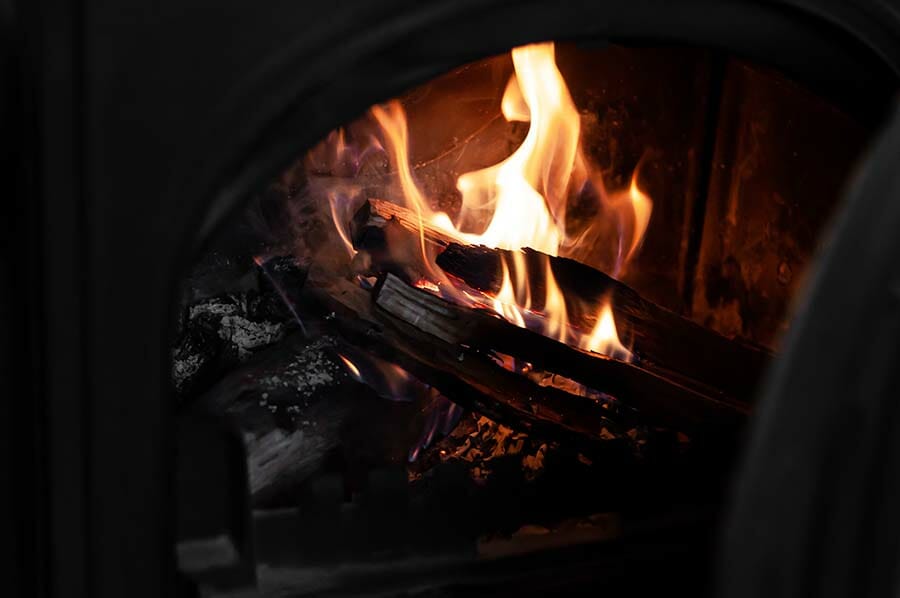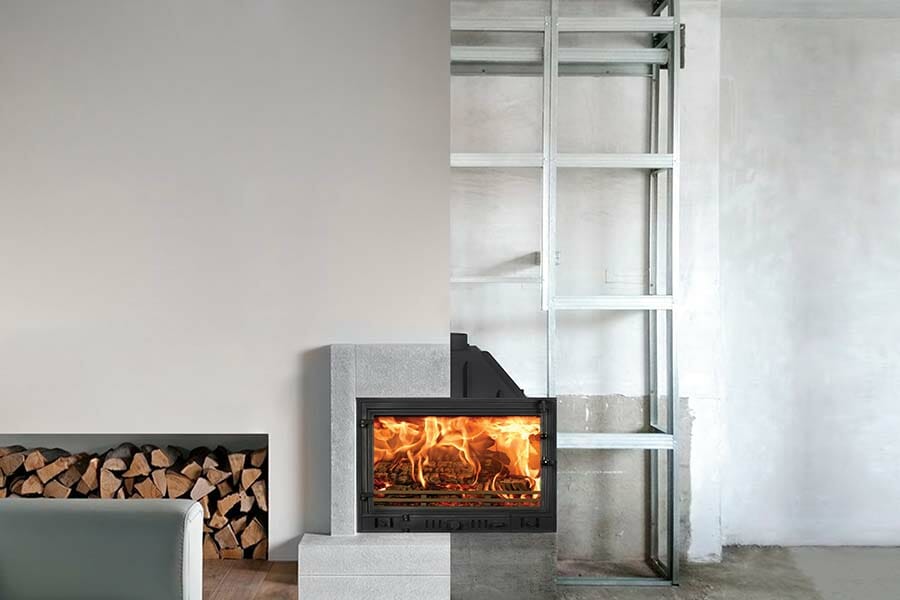- Over firing a wood stove occurs when too much fuel or oxygen has been supplied to the stove beyond its design limits and the extra heat that’s created can damage the stove
- If your wood stove is too hot and you’re wondering what to do: One way to deal with an over-firing wood stove is to throw baking soda/sand/ash on it- you have to be careful not to freak out when you open the door and the flames start shooting out
- You can choke it out with controls if you are able to catch it in time and turn off the stove blower if it has one
- You can also close down the damper a lot, not completely, because a closed down damper can cause gas and smoke to enter your home
- Open up the room’s doors and open the stove door to help supply a rush of cooler air.
- There are only a few stoves that can deal with an overpack or overfires
- According to this Redditor expert, the air inlets on the stoves made after 1993 only allow for a reduction in air. However, an overfire or overpack that has really got going usually can’t be slowed enough
- It’s best to consult your stove’s manual to see how it recommends dealing with overfiring situations
- Because it’s a nonstandard operation of the stove, the stove isn’t really equipped to deal with it
- Another old trick was to stuff your air inlet underneath by shoving a ball of foil into it.
- Generally, the advice is to choke the oxygen supply by closing the air vents, so the fire is starved for oxygen and goes out- however a lot of DEFRA or EPA approved stoves can’t be fully closed because a fully closed vent causes the fire to smoke too much
- You can push the logs closer together and directly into the ashes and embers to help lessen the airflow around them
Contents
What over firing looks like:
A wood burning stove can provide the home with warmth. There may be issues with a wood stove at times. One of the common issues is that the stove can over the fire. If a wood stove is prone to over fire this can cause permanent damage to the unit.
Companies that make the wood burning stove recommend a specific amount of wood that should be loaded into the stove. If there is too much wood in the unit or if there is an increase in airflow through the unit this can lead to an over fire.
Over firing can happen when there are additional levels of oxygen and wood in the stove. This s often more than the amount that has been recommended by the maker of the woodstove. If this happens there can be damage that is done to the stove.
A wood burning stove can only operate within a specific temperature range. If the temperatures become too high from over firing the materials that are used to make the stove will not be able to stand up to the heat- make sure you know what to put behind a wood stove to help fireproof it.
What is over firing?
Over firing can happen when the fire in the woodstove is larger and hotter than what the stove was designed for. This fire is out of the normal range and is putting out more heat than the wood stove would normally provide.
Each model of the wood burning stove has different temperatures they could reach and a different amount of wood that they can hold.
Some are able to use oxygen more efficiently than others to get the fire going and keep it going. Some stoves can produce heat better than others- learn how to get the most heat from a fireplace.
A larger wood stove is able to hold more wood so it can give out additional heat. The amount of oxygen that the wood stove is getting can also impact the amount of heat that it can provide.
When a person purchases a wood burning stove there will be instructions from the manufacturer on how much wood they are able to burn in the stove at one time. The wood will be placed in the firebox.
There will be a maximum amount of wood that can be safely burned in the firebox at one time. If a person puts more wood than recommended in the firebox this can lead to issues and damage.
Over firing in the stove will cause the temperatures to reach unsafe levels. This can also lead to issues with the chimney or the flue of the stove.
As the wood releases smoke it will also leave behind soot or creosote. This can lead to buildup in the flue over time. If the fire is burning too much wood this will lead to faster buildup rates.
The byproduct of Creosote is highly flammable and it will increase the chance of having issues with the chimney including a fire. If the wood burning stove is operating at temperatures above what it should it will lead to the potential to ignite the creosote and cause a fire.
If there is too much wood in the stove there will be too much air that is allowed in the stove. The increase in the air can lead to over firing. When there is too much oxygen in the stove this will cause the fire to grow too large and too hot.
There are air vents on the stove and they must be in a specific position to help control the heat and the fire level.
Some things will lead to an increase in oxygen levels. This includes keeping the door of the stove open or having the air vents wide open. This will allow too much oxygen into the fire and will allow it to get bigger than normal.
Overload and Over Fire
If there is more wood than recommended by the manufacturer in the woodstove this will lead to an overload. The abundance of wood can lead to an over fire. It will also cause damage to the air wash and the burn systems.
There is a clear warning in the operating instructions that the stove should not be overloaded. There is a recommended amount of wood that should be placed in the firebox. It is important that this amount is not exceeded.
There is a specific place to put the wood but the wood cannot exceed the height of the air vents. If there is too much wood in the stove it will preset the smoke and gases from escaping through the air vent.
Too Hot

If the wood burning stoves do over fire and get too hot then there can be issues. The metal in the stove may be damaged. The metal may warp, crack, or it can become weak over time.
If over firing happens often this can lead to issues developing quickly. The stove was designed to handle temperatures to a specific point and exceeding this will lead to damage.
The baffle plate inside of the top of the woodstove may also be damaged. It is the part of the wood stove that is the most at risk for damage due to over firing.
The baffle will hold is cases from the firebox before they are able to go through the flue. If this gets too hot there will be issues with the flue and the heat will be sent back towards the firebox.
Signs of Trouble

If the metal parts of the woodstove begin to glow with a red color (check out these crazy fireplace colors) this is a warning sign that things are getting to be too hot. There is a risk for damage at this time. If the stove begins to crackle it may be taking in more oxygen than needed.
The thermometer on the outer part of the stove should be examined to make sure the fire is not getting hotter than recommended.
A wood stove can provide the home with heat. It is important to follow the recommendations of the manufacturer to prevent the stove from an over fire.

